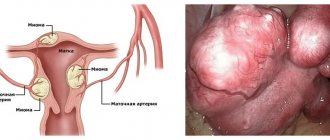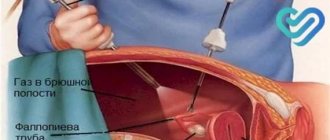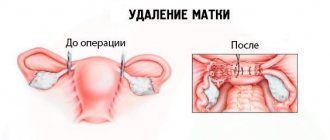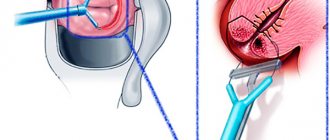Some women require complete removal of the uterus as indicated by their doctor. Such surgical intervention is performed exclusively in rare cases when drug and physiotherapeutic treatment has not brought a positive result. The rehabilitation period lasts a long time, so patients are prescribed medications. Women also need to regularly do gymnastics and physical exercises that will help bring muscle tissue to normal condition. Before performing them, you should consult with your doctor, who will give all the necessary recommendations and advice. In most cases, after surgery and removal of the uterus, women face problems such as spontaneous urination and defecation. During surgery, the doctor excises the muscle layer that supports the body of the uterus. In this case, only Kegel gymnastics will help.
In what cases is a hysterectomy performed?
Reasons for having a hysterectomy:
- Malignant formation - oncology (cervical cancer, ovarian cancer, etc.). In such a situation, there is no question of alternative treatment, since cancer is always a high risk of developing metastases and death;
- Benign formations (the most common disease of the female organs is uterine fibroids);
- Endometriosis (benign formations inside and outside the lining of the uterus);
- Vaginal bleeding of unknown origin;
- Prolapse or complete/partial prolapse of the uterus (quite common in older women when the pelvic floor muscles become weak);
It is important to know and always remember: if there is at least one way to avoid amputation of the uterus, then you should definitely try this method first, and only last resort to radical options.
Many women who have had to deal with such an operation are interested in many questions, mainly related to the behavior of the body in the postoperative period, the ability to lead a normal lifestyle, play sports, have sexual intimacy with their other half, and much more.
Ovariohysterectomy
During the operation, all internal organs of the small pelvis are removed: the ovaries, uterus, fallopian tubes, ligaments and surrounding muscles. The most common and widespread complications include a complete cessation of the production of female sex hormones. Such serious changes in the body lead to the premature onset of menopause.
After removal of the ovaries, pathologies such as osteoporosis occur, heart rhythm is disturbed, and excessive dryness of the vaginal mucosa is noted, even with regular use of hormonal medications.
If you do not moisturize the walls of the vagina, they begin to become easily inflamed and cracks appear during physical activity, as well as sexual intercourse. Patients are diagnosed with a chronic form of irritation and excessive itching. In this case, it is necessary to regularly perform Kegel exercises, which will help establish the correct secretory function of epithelial tissues.
Recovery process
As after any other operation, the patient must adhere to many rules and conditions so that unforeseen circumstances do not arise that could lead to complications.
The entire process of a woman’s recovery after a hysterectomy can be divided into two periods: stay in a medical institution (first period), and home postoperative care (second period). Now let’s find out what can and cannot be done after something like this.
After removal of the uterus you can:
- in the first few hours after surgery, with the permission of the attending physician, get out of bed and walk. This need is due to the risk of developing blood stagnation in the body.
- eat light food, in the form of vegetable or chicken broth, pureed fruit and green or weak black tea.
- take painkillers.
- increase physical activity every day in order to go through the recovery period faster.
After removal of the uterus, it is impossible (it should be noted that restrictions that must be followed in the first 6-8 weeks after hysterectomy will be given here):
- lift, carry and move heavy and bulky objects (fraught with bleeding and suture divergence);
- have sexual intercourse in the first month and a half (the same consequences as in the first paragraph);
- sunbathing in the open sun;
- visit baths and saunas, take a hot bath, swim in open water.
- drinking alcohol;
- eat fatty, fried, excessively salty, sweet foods;
At first, women may experience changeable mood, unstable psycho-emotional state, tearfulness, and sleep disturbances. This is due to a harmonious imbalance that occurs in all women who have undergone this type of surgical intervention. Such symptoms most often go away on their own after the postoperative period.
Kegel exercises after removal of the uterus and ovaries
Hysterectomy (or hysterectomy) is one of the most common operations performed in the gynecology department. This highly traumatic operation has a lot of negative health consequences, so removal of the uterus is carried out strictly according to indications.
However, the issue of rehabilitation and restoration of physical and, most importantly, moral health after the removal of such an important organ has not yet been finally resolved. Severe hormonal disorders, complications and infertility are just a few of the problems that a woman will have to solve after treatment.
How can I help her during this period of her life and how to properly recover after removal of the uterus?
Important! The rehabilitation period depends on the type of surgical intervention. With laparoscopic access, early recovery takes no more than three days. With open access (laparotomy), rehabilitation in a hospital takes 1 week or more.
Rehabilitation and recovery in hospital
Rehabilitation in a hospital after removal of the uterus is primarily aimed at restoring physical and mental health and preventing complications. To achieve this, a number of activities and procedures are carried out.
Rehabilitation and recovery in the first hours after surgery
Here, measures are taken to eliminate pain, replenish blood loss and anemia, and preventive measures to prevent, identify and eliminate infections and thromboembolic complications. For this we use:
- Non-steroidal anti-inflammatory drugs or narcotic analgesics.
- Infusion therapy with blood replacement solutions and electrolytes.
- Broad-spectrum antibiotics.
- Antiplatelet agents and anticoagulants.
The choice of drug and dosage selection is carried out individually by the doctor.
Recovery in the following days
During this period, constant monitoring of the body's condition is necessary. First of all, monitor the passage of stool and gas.
The appearance of urination and defecation indicates the start of normal bowel function.
A delay in physiological recovery indicates complications in the gastrointestinal tract, which is an indication for further diagnostic measures.
During the same period, the prevention of infectious complications and thromboembolism continues. According to indications, patients continue to take painkillers and administer blood replacement solutions.
Nutrition of a woman in the early rehabilitation period
An important aspect of the normal course of recovery and rehabilitation is proper nutrition.
On the first day after surgery, the patient is prohibited from eating any food. In the evening, you can drink half a glass of water.
On the second day, the patient is given low-fat meat broths (chicken, turkey, veal, rabbit) without adding salt and other spices, as well as water.
In the following days, patients are recommended to follow a low-calorie diet with limited salt and sugar. The main goal of such nutrition is to start intestinal motility and peristalsis, without loading the digestive tract itself. Main dishes for the diet after hysterectomy:
- Porridge (Oatmeal, buckwheat, rice, pearl barley).
- Soups made from broths made from lean meats.
- Vegetable purees.
- Pieces of lean meat (chicken, turkey, etc.)
- Yogurts and other fermented milk drinks (but not whole milk).
- Dried black bread.
- Baked fruits.
All dishes are prepared with a neutral taste: not salty, not spicy, not sweet, etc. Food intake is fractional: up to 5-6 times a day. All products that can cause constipation, dyspeptic disorders and motor skills are prohibited for consumption.
Physical activity
An equally important aspect of early rehabilitation is getting the patient out of bed early. After laparoscopic surgery, you can move around the ward after 6-12 hours. In an open form of surgery, the first rise from the bed should occur no earlier than on the second day of the postoperative period.
Important! Early physical activity after hysterectomy is the key to successful treatment and recovery. This is the most effective method of preventing the formation of adhesions and, as a result, adhesive disease - a life-threatening complication that requires long-term treatment and rehabilitation.
In the first days, move around within the ward, then along the corridors and alleys of the hospital.
Recovery and rehabilitation at home
Rehabilitation at home is aimed primarily at maintaining physical health and correcting mental disorders (if any). Here, for a woman, the main thing is attention and care, as well as understanding from loved ones and others.
Source: https://philosophytoday.ru/uprazhnenija-kegelja-posle-udalenija-matki-i/
Consequences of hysterectomy
Any operation carries with it the risk of negative consequences. To minimize all risks, you must follow all instructions and prescriptions of your doctor.
However, be that as it may, such consequences do occur, so it is worth mentioning them:
- risk of infection;
- formation of hematomas;
- loss of sensation in the scar area;
- the appearance of colloidal scars (if there is a predisposition to this);
- adhesions in the abdominal cavity;
- menopause (an inevitable consequence of surgery);
Sexual life after hysterectomy
It is worth immediately making a reservation about a woman’s ability to conceive and give birth after such an operation. Since the reproductive organ has been removed, becoming pregnant and having offspring in the future becomes completely impossible, and therefore the frequent question of inexperienced ladies: “is it possible to get pregnant after removal of the uterus” disappears on its own.
There are situations when a woman has experienced a difficult birth, and during the process, something went wrong (uterine bleeding began), then doctors can make a difficult, but necessary decision to save the mother’s life - to remove the uterus. No one is immune from this, but the fact that a child was born does not so darken the future life, without the possibility of getting pregnant again.
Also, a considerable number of representatives of the fair sex are wary of losing libido - the desire to have sex and receive pleasure from it. Here women can be reassured, since the sensitive endings are located precisely in the vagina, so the pleasure from sexual intercourse will not disappear anywhere, and orgasm is possible with the same probability as in absolutely healthy women.
Many patients who have undergone hysterectomy report more intense orgasms and a more active sex life. This can be explained by the lack of fear of unwanted pregnancy.
The conclusion of this topic suggests itself: sleeping with your husband or just a loved one is not only possible, but also necessary. The main thing is to do all this after 6-8 weeks.
Why is it necessary to perform a gymnastic complex for women with a removed uterus?
It is known that the perineal muscles are very important for the normal functioning of a woman’s body. First of all, they are responsible for the performance of the internal genital organs, gastrointestinal tract and bladder. The natural (normal) performance of functions by the above organs directly depends on the current state of muscle tissue in this area. After surgical removal of the uterus, you should regularly perform Kegel exercises for the following reasons:
- For rapid recovery of physical and psychological condition as a result of the operation;
- To increase the tone and level of elasticity of muscle tissue in order to enjoy sex;
- To strengthen the muscles of the vaginal muscle tissue.
Sports activities
Especially active patients who love sports and cannot imagine life without it are concerned with the following question: “is it possible to play sports after removal of the uterus.”
Sport is life, and no one will argue otherwise.
After the operation, when 2-3 months have passed, you can try yourself in light types of fitness. This could be regular walking in the evenings, yoga, breathing exercises, Pilates, bodyflex.
It has long been proven that women who do not neglect fitness or even regular gymnastics can protect themselves from such unpleasant postoperative consequences as:
- haemorrhoids;
- pain during sexual intercourse;
- adhesions and blood clots;
- depression;
- urinary incontinence;
- frequent constipation;
Doing Kegel exercises is very helpful. Many women have long heard about them. Just a few minutes a day, by squeezing and relaxing the muscles of the vaginal walls, you can protect yourself from the above unpleasant consequences, as well as increase sexual sensations.
Riding a bicycle is a completely acceptable and enjoyable activity. The main thing is not to do this if 3 months have not passed after the operation, and not to raise the seat high in order to avoid heavy stress.
Sports after hysterectomy: is it possible to do sports?
A hysterectomy is a surgical procedure in which the female reproductive organ is removed. This operation is very common in gynecology. The uterus is removed in cases where all other treatment methods have been ineffective.
Sometimes the uterus is removed along with the fallopian tubes and ovaries. The postoperative period is an important stage in a woman’s treatment, which may be accompanied by the development of complications, so it requires a professional approach.
Surgery to remove the uterus is quite common.
which is carried out for very serious illnesses that threaten a woman’s health. According to statistics, about a third of all women who have reached the age of 40 are forced to resort to such a procedure.
With any surgical intervention, injuries of varying severity occur, which are associated with damage to tissues and blood vessels. After a hysterectomy, damage also remains, and it takes time for the tissue to fully recover. The duration of postoperative rehabilitation depends on the severity of the disease, the type of surgery and postoperative complications.
Most often, removal of the uterus is indicated in the following cases:
X:
Depending on the severity of the disease
carry out the following types of operations:
- removal of the uterus only;
- removal of the uterus and cervix (total extirpation);
- removal of the uterus with appendages and lymph nodes located nearby (radical panhysterectomy).
How severe the trauma will be depends not only on the type of operation, but also on the method of its implementation.
The most radical is the abdominal technology, in which the walls of the peritoneum are cut, and another method is the vaginal method with an incision in the vagina. The least traumatic method is to remove the uterus using the laparoscopic method.
In this case, a special laparoscope is used, which makes a very small incision. After laparoscopic surgery, complications are not so dangerous.
How long do you stay in hospital after a hysterectomy?
It depends on the type of operation. After laparoscopy, the patient can be discharged the next day
. If abdominal surgery was performed, the patient can go home after 2 to 3 days.
Principles of rehabilitation
Recovery after surgery is divided into early and late stages. The early stage is carried out in a hospital setting under the supervision of a doctor.
Its duration depends on the consequences that occurred after surgery.
The early stage of recovery after abdominal surgery usually lasts 9–12 days, after which the doctor removes the stitches and the patient is discharged. After laparoscopy, early rehabilitation is reduced to 3.5 – 4 days.
Main tasks
early stage of rehabilitation are:
- relief from pain syndrome;
- elimination of bleeding;
- prevention of dysfunction of internal organs;
- avoiding infection of the affected area.
The late stage of rehabilitation is carried out at home.
If complications do not develop after the operation, then recovery takes 28–32 days, and in case of complications it is extended to 42–46 days.
This stage is characterized by complete restoration of tissues, strengthening of the immune system, improvement of general condition, normalization of the psychological state, and complete restoration of performance.
Indications for implementation
Often, after surgery to remove the uterus and appendages, women may encounter various problems. Ligaments are damaged and weakened, as well as the muscle tissue of the pelvic diaphragm, internal organs are displaced and the mucous membrane is not sufficiently moisturized. All these problems can be solved by systematically performing Kegel exercises.
The main indications include:
- prolonged and difficult wound healing after surgery;
- formation of adhesions;
- constipation;
- the appearance of hemorrhoids;
- blood clots;
- pain and discomfort during sexual intercourse;
- spontaneous urination and defecation.
Wounds begin to heal quickly, serious complications are prevented, scars and adhesions do not appear. After surgery to remove the uterus and pelvic organs, Kegel exercises help normalize blood circulation, so blood stagnation does not occur. They can cause varicose veins and bleeding after surgery.
What measures are taken immediately after surgery?
On the first day after surgery
Source: https://g-women.ru/matka/gimnastika-posle-udaleniya-miomy.html
Menopause
When a woman loses one of her main reproductive organs, she experiences menopause - the cessation of menstrual function and the inability to conceive. This condition is relevant due to the cessation of the synthesis of sex hormones.
Young women have the hardest time in this situation. She needs to go through not only all the stages of treatment and recovery, but also come to terms with the fact that she will no longer be able to experience the happy moments of motherhood.
The main thing here is not to panic or become disheartened.
Today, there is hormone replacement therapy that will allow a woman not to experience all the pangs of menopause and feel young and thriving. This type of therapy is prescribed by the attending physician. The most important thing is to follow all recommendations.
Diet
After a woman has lost her uterus, she not only has to go through all the stages of restoring the body, but also remember once and for all that any imbalance of hormones can lead to significant fluctuations in weight.
Therefore, following a diet is not just a recommendation from your doctor, but also a motto for life, which if you follow, you will remain in harmony with your body and soul.
Basic diet requirements:
- drinking enough fluid (women who have undergone surgery run the risk of dehydration, and this in turn leads to completely different, no less dangerous diseases. So make it a habit to drink an average of 1.5-2 liters of clean water a day).
- fractional meals (food should be taken in small portions, 150-200 grams, but quite often - 5-6 times a day).
- You should avoid foods that lead to gas formation and constipation (baked goods, coffee, strong black tea, chocolate).
- eating foods that increase hemoglobin. Such products include: buckwheat, pomegranates, dried apricots, red meat. This rule is relevant in the first weeks of the postoperative period, since any operation leads to significant blood loss.
- Do not subject products to prolonged heat treatment.
- eat more vegetables, fruits, fiber, foods rich in microelements and vitamins.
It cannot be said that such rules are necessary especially for those who have lost their reproductive organs. Any woman who follows a healthy diet can avoid many unpleasant diseases, as well as prolong her youth and beauty.
Be that as it may, any operation is not at all pleasant and difficult for a person, but removal of the uterus after childbirth is not a death sentence after which life loses its meaning. A woman decides for herself whether to be happy. The psycho-emotional mood is very important here. It’s not for nothing that they say that thoughts are material. You should definitely set yourself up for the best. Having lost her main reproductive organ, a woman still remains a woman.
Video: Removal of the uterus and possible consequences
Removal of the uterus and possible consequences
Features of the exercises
A radical surgical intervention aimed at removing the uterus rarely leaves its mark on women’s health. As a result, difficulties in the processes of defecation and urination may be provoked, or, on the contrary, excessive, sometimes uncontrollable speed of these processes. The reason for such problems lies in the fact that during the operation the tissues and ligaments responsible for the physiological processes of the body were affected.
Gymnastics after uterine amputation is an effective therapy in the presence of similar symptoms. Classes are allowed at home. The body position can be any sitting, standing, lying down. The main condition is the comfort and positive attitude of the woman performing the exercises.
It is quite natural that drastic physical exercises are not recommended for a woman who has undergone uterine amputation. To maintain good physical shape, leisurely and relaxing types of physical activity are quite suitable for the fair sex: yoga, bodyflex and Pilates.
A woman’s physical activity after uterine amputation must be as gentle as possible
With the permission of the attending physician, a woman is allowed simple exercises and a number of simple exercises of the following type:
- Standing on all fours, alternately (slowly) arch and unbend your back;
- Sitting on the floor, stretch your legs straight forward. Bending your torso, touch the fingers of the upper extremities to the fingers of the lower extremities;
- Lying on your back, alternately pull your lower limbs bent at the knees towards you.











